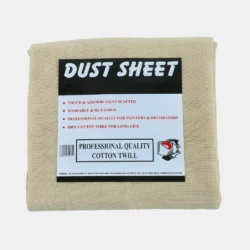-
Standard Cotton Dust Sheets
Standard Cotton Dust Sheets – 12’x9′
£7.74 – £473.23 Select options This product has multiple variants. The options may be chosen on the product page
Cotton Dust Sheets: A Breath of Fresh Air for Eco-Conscious Brits
In the UK, where DIY reigns supreme and home improvement projects are a national pastime, dust sheets are essential companions. But with a growing focus on environmental responsibility, many Brits are wondering: are traditional cotton dust sheets the most eco-friendly option?
The answer, like most things in life, isn’t entirely black and white. Let’s delve into the world of cotton dust sheets, exploring their eco-credentials and weighing them against potential downsides.
The Case for Cotton: A Natural Choice
Cotton boasts several eco-friendly advantages:
- Renewable Resource: Cotton plants are readily renewable, unlike the finite resources used to produce some synthetic dust sheets.
- Biodegradable: When their useful life ends, cotton sheets decompose naturally, leaving minimal impact on landfills.
- Breathable: Unlike plastic alternatives, cotton allows surfaces to breathe, preventing moisture build-up and potential damage beneath the sheet. This is particularly crucial for protecting wooden furniture and floors.
- Reusable: High-quality cotton dust sheets can be washed and reused countless times, significantly reducing waste compared to disposable options.
Considering the Cotton Lifecycle
While cotton itself seems like a green champion, its journey from field to fabric isn’t always picture-perfect. Here’s where some potential downsides come in:
- Water Usage: Cotton production can be water-intensive, especially in regions with limited resources. However, choosing organic cotton or brands committed to sustainable water practices can significantly lessen this impact.
- Pesticides and Chemicals: Conventional cotton farming often relies on pesticides and fertilizers. Look for GOTS (Global Organic Textile Standard) certified cotton dust sheets to ensure minimal chemical use.
- Manufacturing Processes: The dyeing and finishing processes used on cotton can involve harmful chemicals. Opting for natural dyes and eco-conscious manufacturers can make a difference.
The Eco-Alternatives: A Look at What’s Out There
While cotton shines in many aspects, there are alternatives to consider:
- Recycled Plastic Dust Sheets: These sheets offer some level of reusability and keep plastic waste out of landfills. However, they may trap moisture and lack breathability.
- Oxo-Biodegradable Dust Sheets: Made with plastics engineered to break down faster, these can be a good option if reusability isn’t a priority. However, the breakdown process can still take years and may not be truly eco-friendly.
Making the Most Eco-Conscious Choice
So, are cotton dust sheets the ultimate eco-friendly option for Brits? It depends on your priorities:
- For frequent use and long-term value: Choose high-quality, GOTS-certified cotton dust sheets. Wash them properly to ensure longevity and reduce waste.
- For occasional use: Consider recycled plastic sheets, but be mindful of potential moisture issues.
- For single-use projects: Opt for oxo-biodegradable sheets as a slightly better alternative to traditional plastic, but remember, they aren’t a perfect solution.
The Final Word: A Sustainable Dusting Approach
The most eco-friendly approach goes beyond the material itself. Here are some additional tips:
- Buy the right size: Ill-fitting sheets lead to excessive use and potential damage.
- Proper storage: Store your dust sheets neatly to prevent rips and tears, extending their lifespan.
- Explore alternatives: Can you use drop cloths or old sheets for smaller projects?
By making informed choices and prioritizing reusability, Brits can ensure their dust-busting efforts are kind to the environment. Remember, a little eco-awareness goes a long way, and every step towards a sustainable future counts.




